Flower names begin with all letters of the alphabet, from anemones to zinnias, and some of the most beautiful flowers have names that start with the letter P. Some of the most stunning flowers that start with the letter P include petunias, pansies, poppies, peonies, periwinkles, pinks, pogonias, pincushion flowers, prunellas, and poinsettias. Learn about these flowers and more below.
1. Peonies
One of the most beautiful flowers, peonies are prized not just for their huge, colorful blooms of red, white, or pink but for their foliage. Peonies come in several forms and do best in hardiness zones 3 to 8. Once established, peonies are long-lived shrubs that grow from 18 inches to 3 feet tall in the garden. They thrive in full sun to light shade in fertile, loamy, well-drained soil.

Beautiful peony flowers bloom in the spring.
©alex172/Shutterstock.com
2. Pansies
These flowers are loved for their sweet “faces” that hold colors that range from white to blue to yellow to velvety shades of black. These flowers are perennial, which means they return year after year from late spring to early fall, though some gardeners treat them as biennials. Biennials are plants that take two years to mature, then die. Pansies are best started from seed indoors and planted when the danger of frost is past. They do best in hardiness zones 3 to 9. Place them in partial shade in soil that is moist but well-drained.
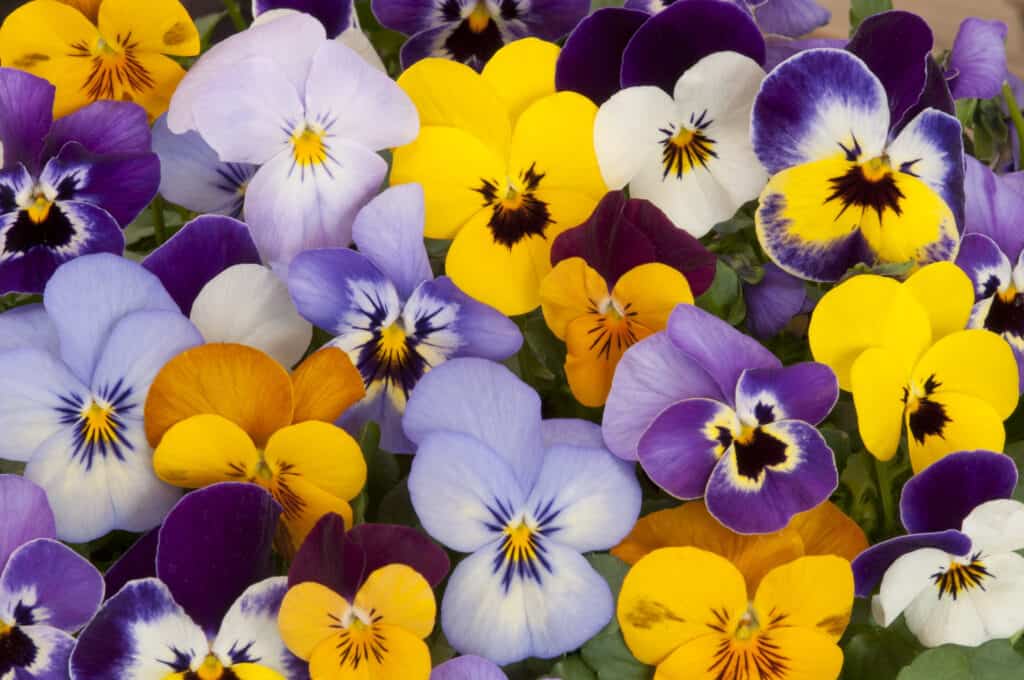
These flowers are perennial, which means they return year after year from late spring to early fall.
©Anjo Kan/Shutterstock.com
3. Penstemons
The tubular bright red, pink, white, or lavender flowers of this plant appear in summer through fall. They need a good amount of sun and soil that’s well-drained, though they don’t need to be overly fertile. Also called beardtongue, the plant grows from 18 to 36 inches tall, which makes it good for borders and beds in the garden. Penstemons are easy to grow from seed and are tolerant of drought. They’re also popular flowers for floral arrangements.
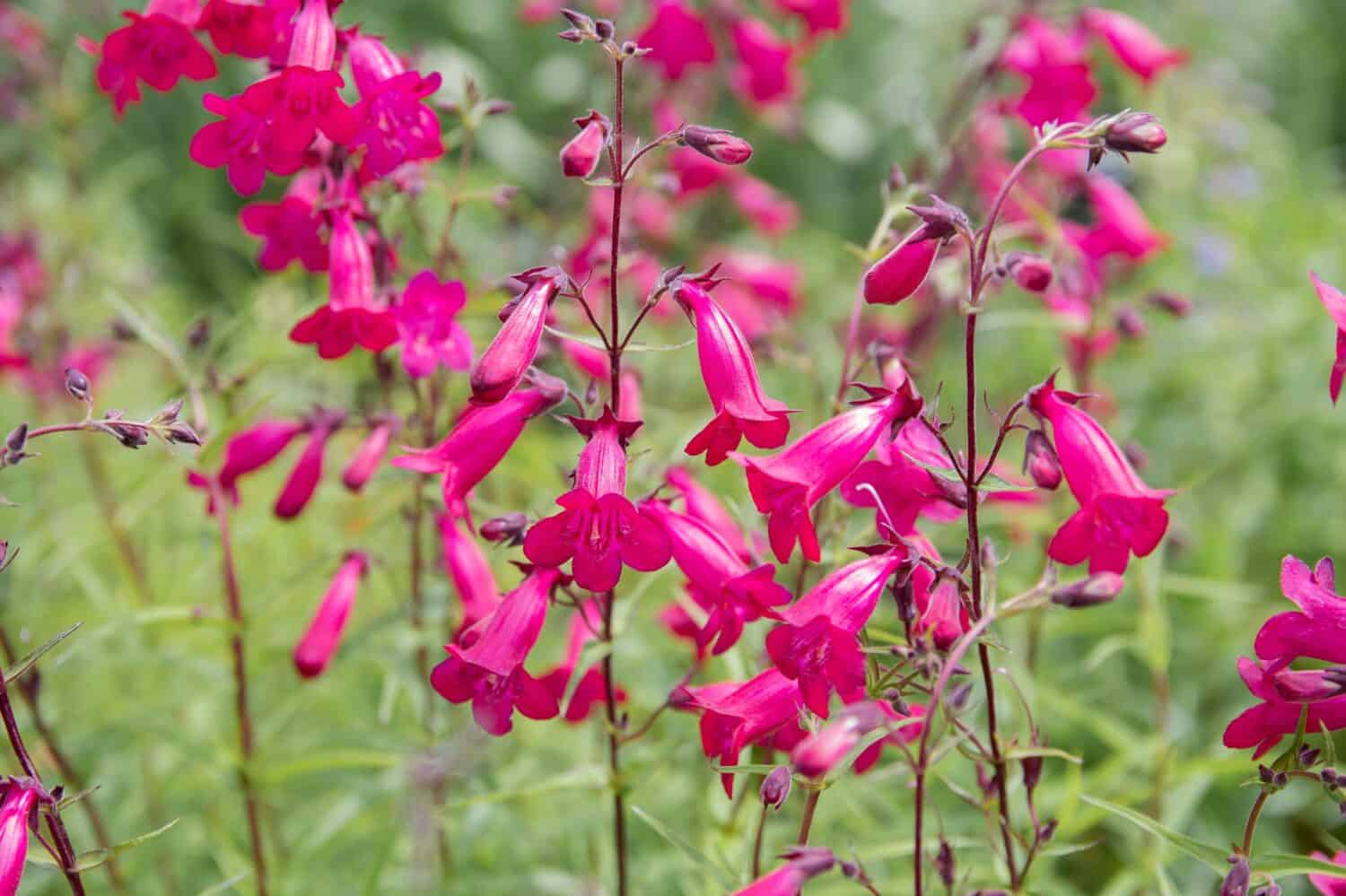
These tubular bright pink flowers are popular for floral arrangements.
©litts/Shutterstock.com
4. Phlox
Phlox is known for its delicate, five-petaled flowers in shades of red, pink, purple, blue, and white. Because some varieties of phlox grow to only 3 inches tall, they can be used as a beautiful, easy-to-maintain ground cover. Other types can grow as tall as 4 feet and are used in borders. This versatile plant can be grown in full sun to full shade in soil that’s dry and sandy to soil that’s moist and rich. It grows best in hardness zones 3 to 9 and blossoms from spring until fall.
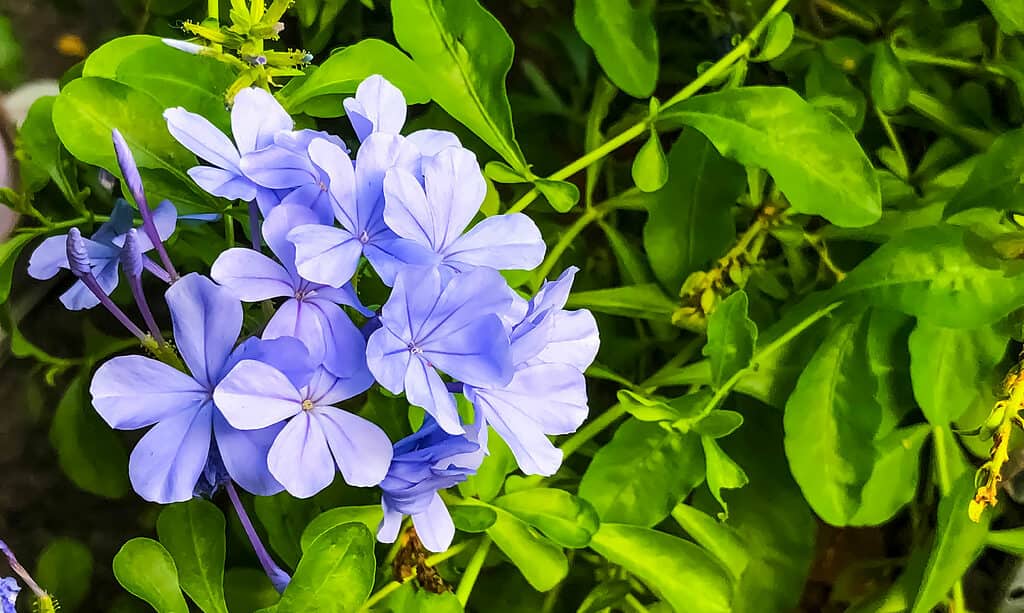
Some varieties of beautiful phlox can be used as a ground cover.
©Arpon Pongkasetkam/Shutterstock.com
5. Poppy
The poppy can also thrive in a wide range of hardiness zones, from 3 to 9. It’s big flowers, which are sometimes 8 inches across, arrive in colors of brilliant red, white, orange, pink, and yellow. The petals are known for their silken texture and for being nearly translucent when the sun shines through them. The stems that bear the flowers are wiry and the leaves are fine cut, hairy, and low to the ground. Oriental poppies can be grown from seed, and they need to be planted about 1.5 feet apart in loamy, well-drained soil in full sun to part shade.

Poppies are almost translucent when the sun shines through them.
©Olga S photography/Shutterstock.com
6. Passionflower
This bloom lasts only a day or so but is memorable. The passionflower gets its name due to the arrangement of the style and stamens in its center, which are reminiscent of the wounds of Christ on the cross. The plant is a broad leaf evergreen and a climber, so it is perfect for arbors and trellises in warmer climates. Indeed, the passionflower can be a little aggressive and gardeners shouldn’t hesitate to prune it harshly if necessary.
The five petals and five sepals are greenish white. These 10 sepals and petals represent the apostles, save Judas and Peter. There’s a corona within them made of threads that are usually blue at the top, white in the middle, and purplish blue at the bottom. In the fall, the plant produces a yellow berry. Found extensively throughout the south, the passionflower blossoms in summer and is good for zones 7 to 11.

The plant is a broad leaf evergreen and a climber, so it is perfect for trellises in warmer climates.
©Tohuwabohu1976/Shutterstock.com
7. Pelargonium
This is another name for the geranium, the beautiful native of South Africa that is popular as a house plant. The other type of geranium is called the cranesbill and looks nothing like it, though they’re related. Pelargonium blossoms arrive in shades of white, red, pink, rose, orange, or variegated. Depending on the varietal, they appear from late spring to early summer, summer to early spring, or mid-spring to mid-autumn. The flowers aren’t nearly as fragrant as the velvety, fan-shaped leaves, which make the plant attractive even when there are no blooms. The pelargonium requires average potting soil, bright but not direct light, and air that’s a bit dry. These flowers love coolish temperatures, though it shouldn’t drop below 40 degrees Fahrenheit.
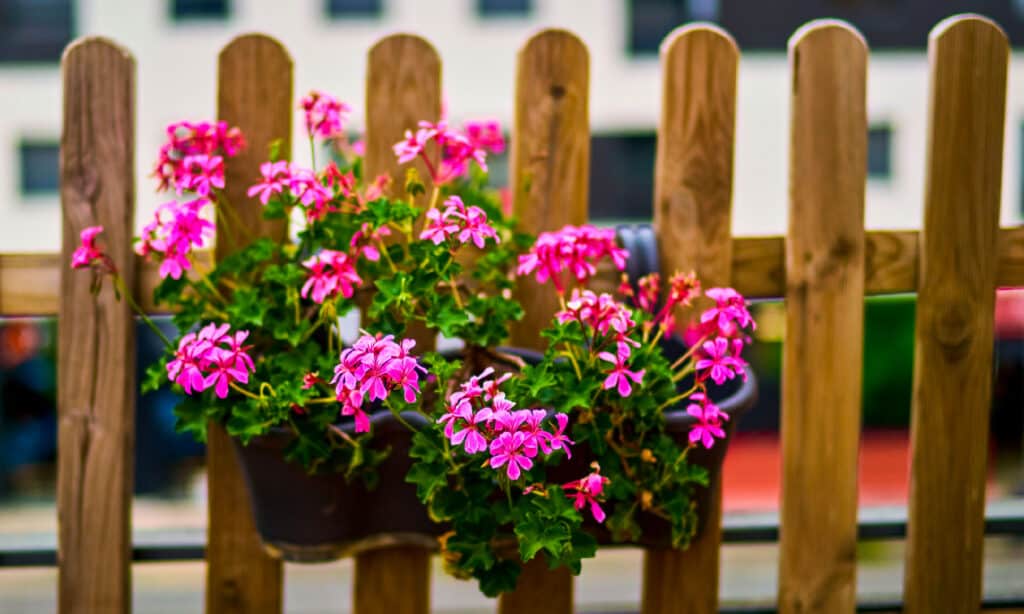
Pelargonium blossoms arrive in shades of white, red, pink, rose, orange, or variegated.
©iStock.com/Jose Gulias Trigas
8. Periwinkle
This plant blossoms in early spring to early autumn. The leaves are evergreen, and even without its bluish-purple, funnel-shaped flowers, the periwinkle, specifically the Vinca minor species, makes an excellent ground cover. It’s especially useful in semi-shady areas around the garden. Periwinkle plants like soil that’s well drained yet moist but tolerates other types of soil. Be careful not to over-fertilize vincas.
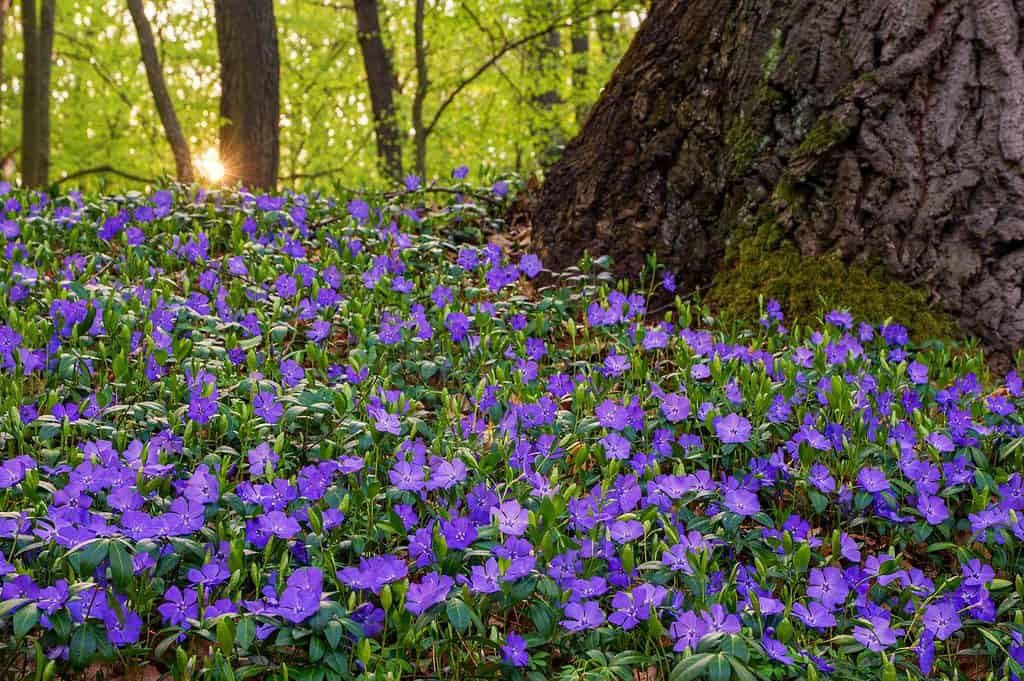
The native range of periwinkle species include parts of Europe, Asia, the Mediterranean, and North
Africa
.
©Kluciar Ivan/Shutterstock.com
9. Pinks
These flowers get their name because most of them are indeed shades of pink. The indented edges of the petals may also remind some people of cloth cut with pinking shears. Like pelargonium, the leaves of these plants are also attractive, and their colors range from a silvery green to bright, primary green. Pinks do best in hardiness zones 3 to 9 and prefer full sun and fertile soil that’s well-drained but never completely dry. Flowers arrive in the spring and last till fall, and the plants are easy to transplant. Pinks are easy to grow from seed, and since different varieties grow in heights from 3 inches to 3 feet, they can be used as ground covers or parts of an herbaceous border or bed.
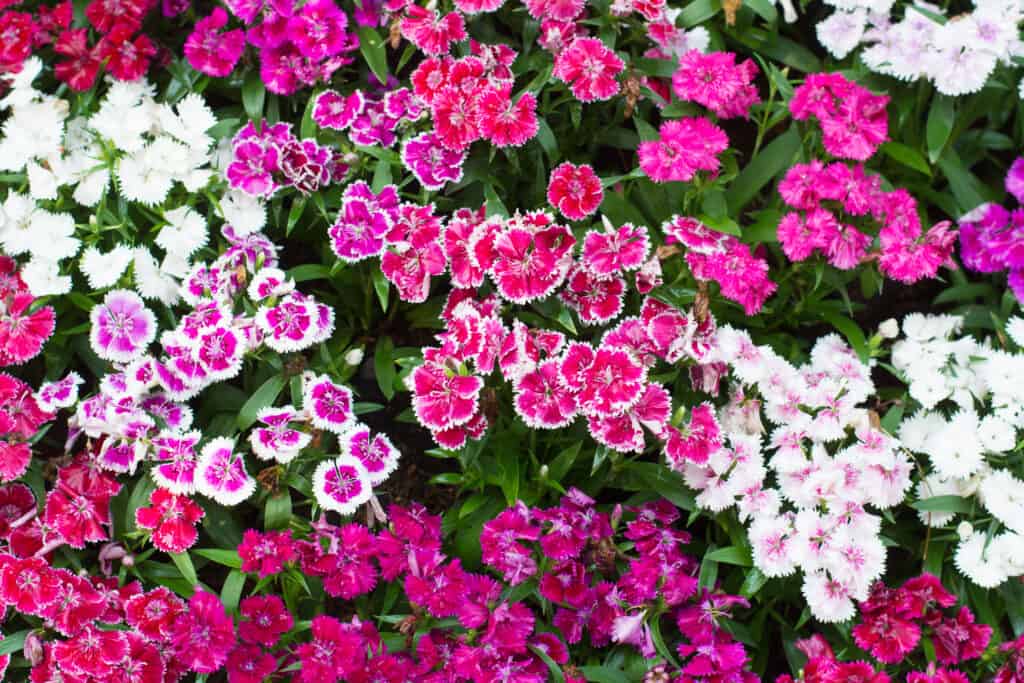
Pinks actually come in a variety of colors besides pink!
©joloei/Shutterstock.com
10. Pincushion Flower
This exceptionally beautiful flower not only enhances the look of any garden but attracts pollinators. It gets its name because its stamens stick up like pins stuck in a pincushion, but it is far more comely and much less prickly. Best grown in hardiness zones 3 to 7, its floral colors include lavenders, reds, creams, whites, and reds. Like so many other plants, the pincushion flower likes soil that is well-drained but isn’t allowed to dry out completely. It also prefers full sun but can do well with brief periods of shade. The flowers arrive in clusters, with each plant producing as many as 50 blooms. Deadheading the flowers after they’re spent keeps the plant producing more.
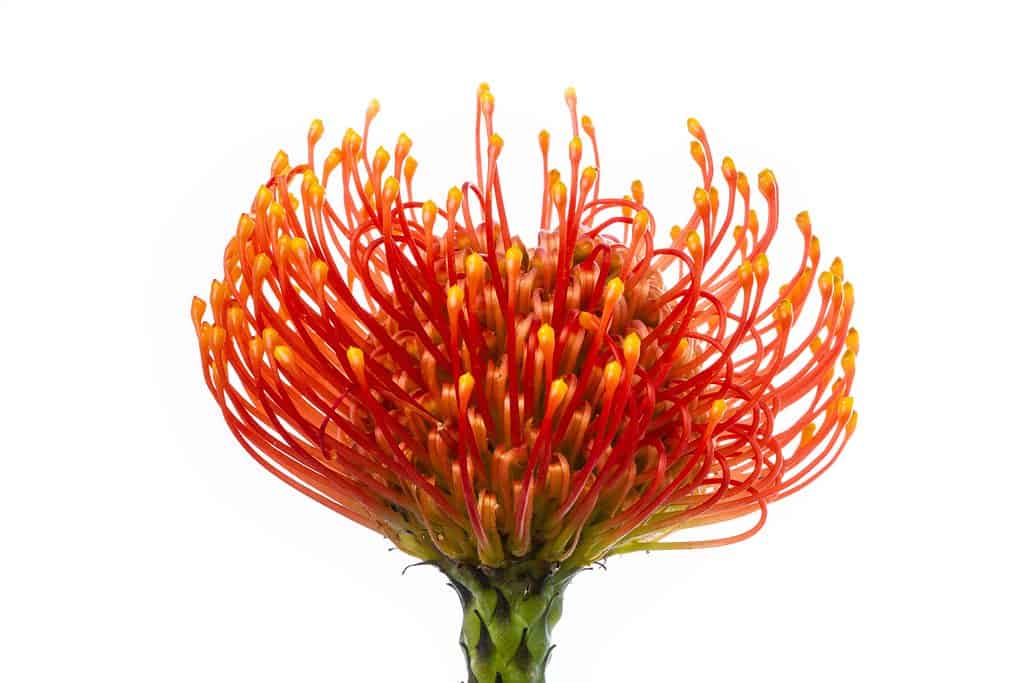
Best grown in hardiness zones 3 to 7, its floral colors include lavenders, reds, creams, whites, and reds.
©Dmitri Gomon/Shutterstock.com
11. Primula
Primulas are a large genus of beautiful flowers. This genus includes hundreds of species, including the primrose. The flowers, which come in hues of yellow, pink, white, blue, purple, and red, usually appear in the spring. They are borne in round umbels, which are clusters that originate from one point. Primula vulgaris is native to cool woodlands in hardiness zones 4 to 9. It likes soil that’s heavy and moist in full sun to partial shade. It’s also an excellent flower for gardens near the ocean and can be used as a ground cover.

The flowers, which come in hues of yellow, pink, white, blue, purple, and red, usually appear in the spring.
©tony mills/Shutterstock.com
12. Polemonium
Also called Jacob’s ladder, this pretty flower enjoys hardiness zones 4 to 9. It is blue violet with bright yellow stamens and arrives from middle to late spring. Its foliage is also attractive and resembles fern fronds. The plant gets its name because of the leaflets that remind people of Jacob’s dream of a ladder climbed by angels. The flowers are about 1 inch across, and the plant grows between 18 and 24 inches tall, which makes it great for borders and beds. Like primulas, polemonium is good for seaside gardens. It flourishes in soil that is fertile and kept moist. Though it can be grown in full sun, it shouldn’t be planted in areas where the sun is intense for much of the day. As a bonus, this flower is mostly pest free, and deer tend to leave it alone.
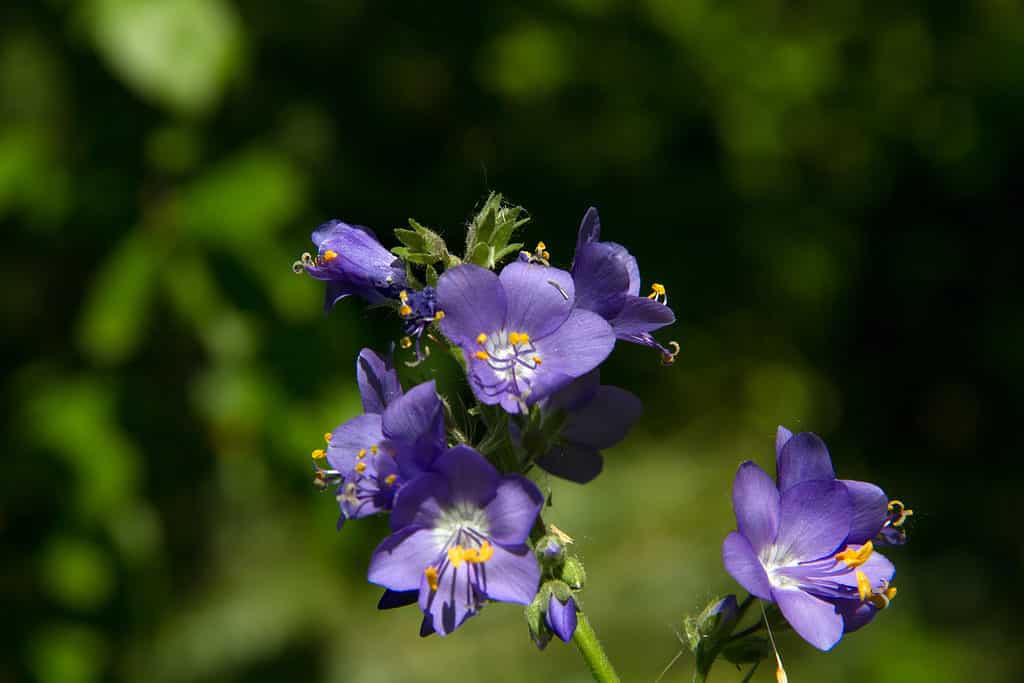
Like primulas, polemonium is good for seaside gardens.
©Alex Kinval/Shutterstock.com
13. Portulaca
Portulaca, also called the moss rose, produces multi-colored flowers in shades of pink, yellow, orange, red, purple, and lavender with delicate petals that can be around 1 to 3 inches across. They may remind you of tiny roses with fine leaves. Most open only during the day when the sun is bright. They close up at night and won’t open on cloudy days. The plant is only about 3 to 8 inches tall, so it makes a great ground cover, especially in dry, hot places that other plants find inhospitable. Portulaca can be planted in hardiness zones 2 to 11, which means it does well in places where winters are harsh as well as places where winters are warm. It’s also an excellent plant for a rock wall or rock garden.
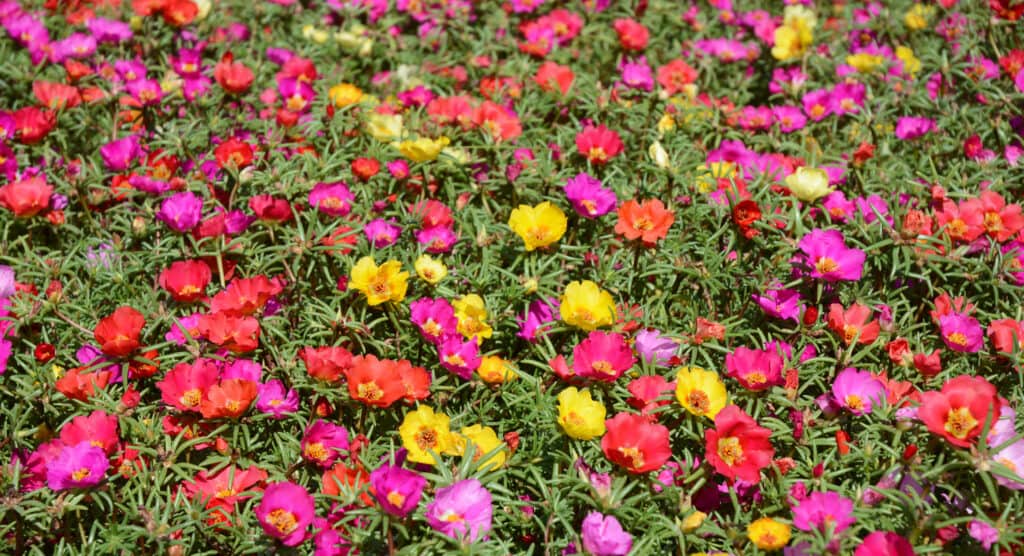
Portulaca flowers are also called moss roses.
©iStock.com/Lex20
14. Potentilla
Potentillas, or cinquefoils, grow as rounded shrubs full of small, colorful blossoms that arrive in spring and last till fall. It does best in hardiness zones 2 to 8 with at least six hours of sun and benefits from some shade in the warmer parts of its range. The soil should be fertile, well-drained, and not completely dry. Some potentilla varietals grow to only 3 inches high and can be used as ground cover, while others are 4 feet tall and 5 feet wide. Potentilla is not just a beautiful plant to behold but it has medicinal properties as well. It’s been used for centuries as a tonic for upset stomachs.

Potentilla is also called cinquefoil.
©Edita Medeina/Shutterstock.com
15. Prunella
This plant does best in hardiness zones 4 to 9 and is grown for its tube-shaped pink, purple. or white flowers that open from the bottom to the top of square stems. Besides their beauty, the flowers are valued for attracting pollinators such as bees and butterflies. Later, the seeds are eaten by wildlife, and the leaves are eaten by people. Prunella is often used as a ground cover but is also planted by bodies of water and roadsides. An easy plant to grow and maintain, it can become a little invasive if it’s not controlled. Also called selfheal, it has medicinal value, and the entire plant can be used to heal wounds and ease fevers. Prunella prefers full sun to partial shade and isn’t fussy about soil as long as it’s damp. This plant is also deer resistant.
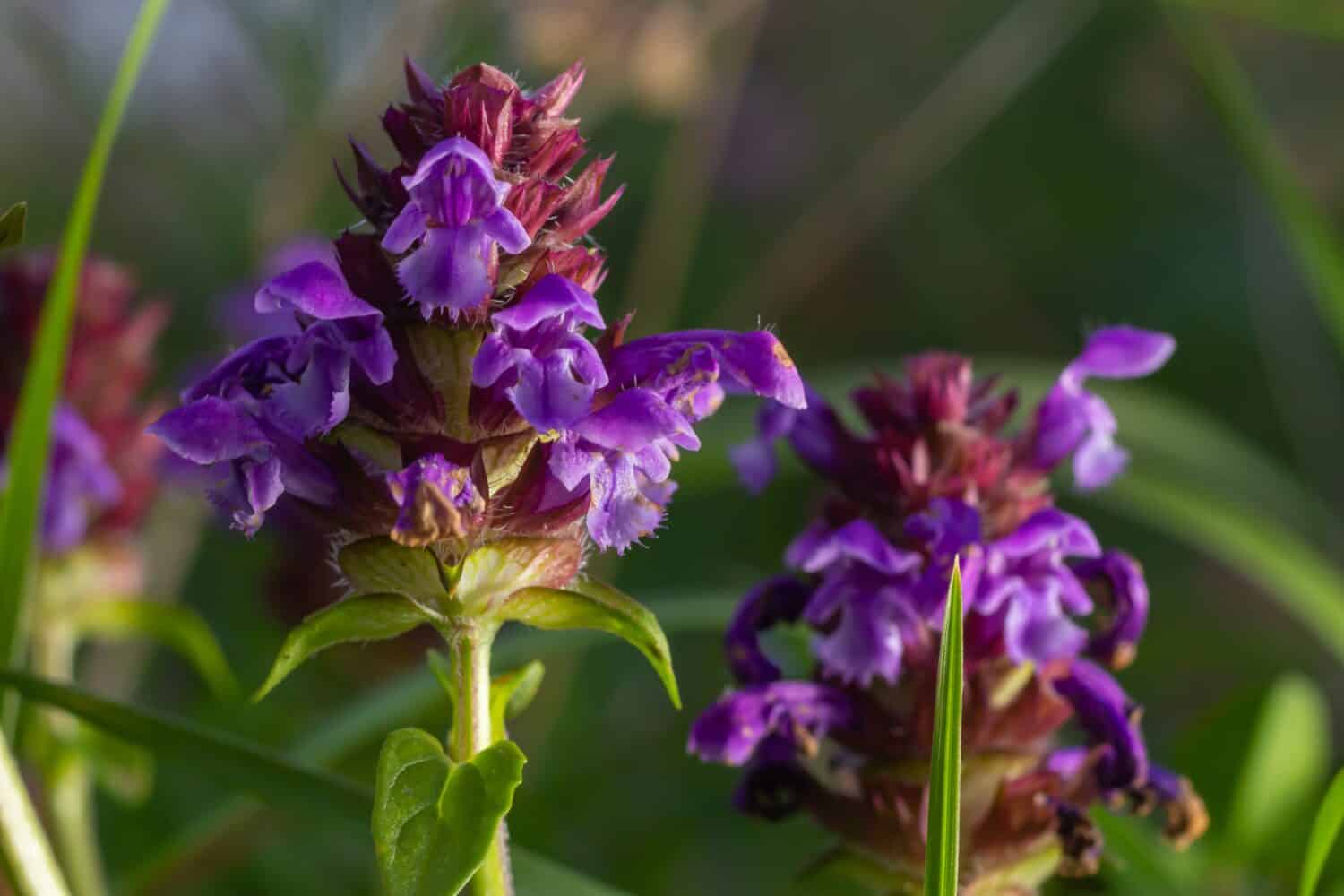
Also called selfheal, this plant has medicinal value, and can be used to heal wounds and ease fevers.
©olko1975/Shutterstock.com
16. Pulmonaria
Pulmonaria is a great plant for shade, as it grows between 6 to 12 inches tall with bell shaped flowers that arrive in early spring, well before other spring-blooming plants. At first, they’re pink, then they turn a stunning blue-violet. Though the flowers don’t last long, gardeners find the plant’s fuzzy, spotted leaves nearly as pretty. The plant gets its other name of lungwort because its leaves are allegedly lung shaped.
Pulmonaria plants need regular watering, if they are planted beneath a tree or around other plants. However, the soil shouldn’t become soggy, for soil that stays wet leads to root rot. The pH of the soil also needs to be right, and the best pH for this plant is a bit alkaline, at 7.5. They also don’t need a lot of fertilizing, as a soil that’s too rich reduces their flowering. Pulmonaria grows best in hardiness zones 3 to 8.
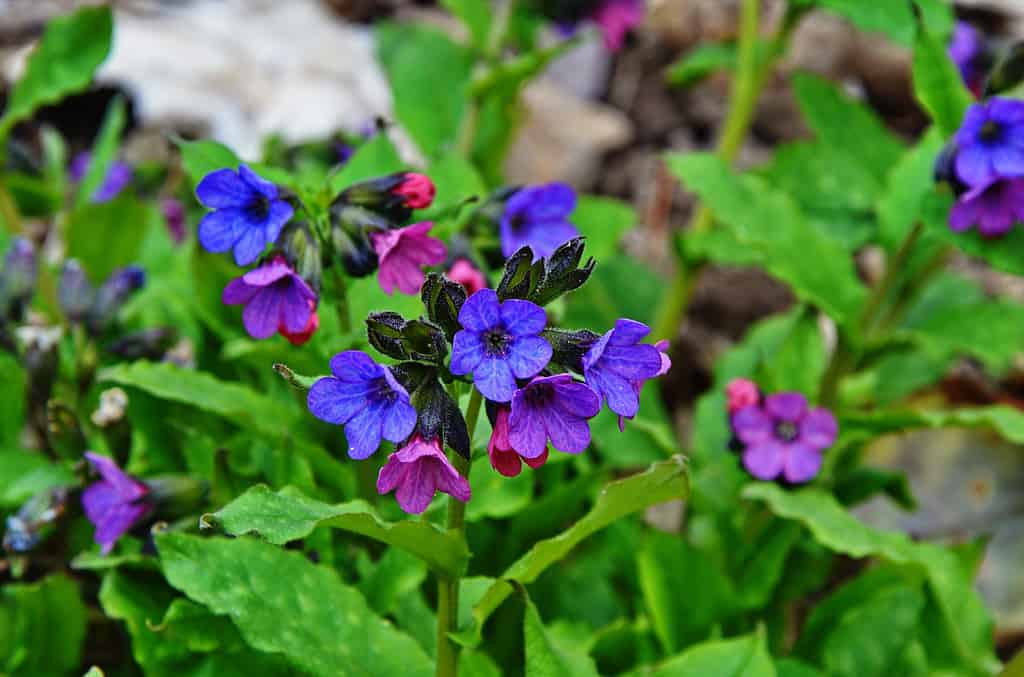
Lungwort can be vivid shades of purple, pink, or blue.
©weha/Shutterstock.com
17. Puschkinia
Native to Asia minor, puschkinia is grown from bulbs and is actually a cousin of the asparagus! Growing only around 6 inches high, it is great for rock and woodland gardens. The flowers blossom on a single spike. They are pale, sky blue with a single blue stripe down each petal, which contrasts beautifully with the lance-like, deep green foliage. It blooms in late winter or earliest spring and is one of the few plants that can be planted underneath or even near a black walnut tree. (Black walnut tree roots secret a toxin that kills most plants near it.) Puschkinia does best in hardiness zones 4 to 8 in full sun to partial shade. Like daffodil bulbs, puschkinia bulbs should be planted 3 inches apart and 3 inches deep.
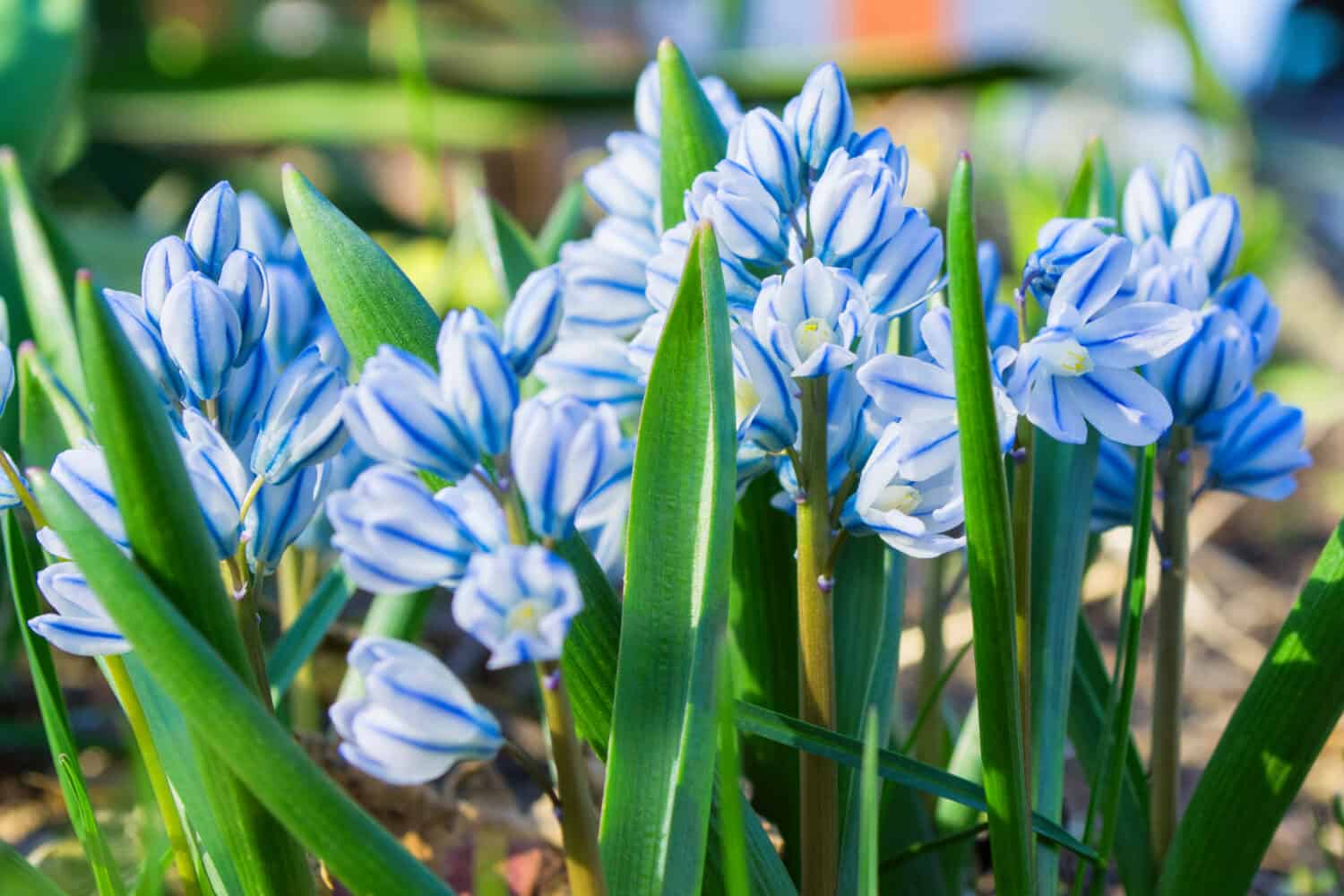
They are pale sky blue with a single blue stripe down each petal.
©DMC-13/Shutterstock.com
18. Pyrethrum
Also called the painted daisy, this plant’s extract serves as an insect repellent. Some varietals look just like daisies, with rays of pure white petals and yellow centers, while others come in shades of pink, purple, or red. The plants grow from 2 to 3 feet tall, bloom in early summer, and have a lovely smell. Additionally, flowers develop above a mound of leaves that resemble fern fronds. These characteristics make it a good flower for herbaceous borders and cutting and cottage gardens. Pyrethrum prefers full sun and soil that’s a bit acidic with good drainage. It thrives in hardiness zones 3 to 7 and tends not to do as well in really hot climates.
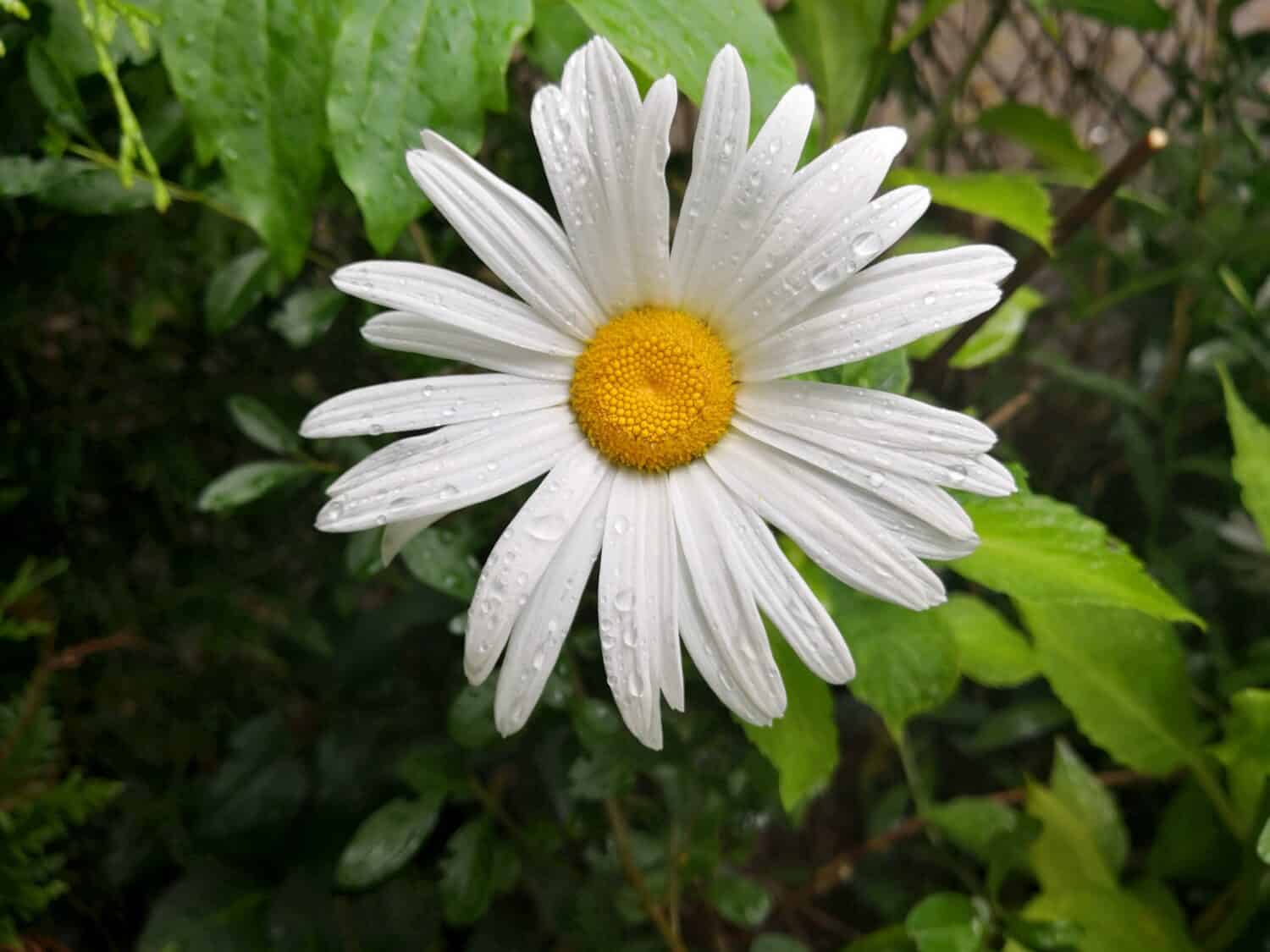
Also called the painted daisy, this plant’s extract serves as an insect repellent.
©Burning Bright/Shutterstock.com
19. Pasqueflower
Even its scientific name, Pulsatilla, starts with a P! Pulsatilla is Latin for “beaten,” because of the way the flowers are “beaten” by the wind on blustery days. This showy flower gets its common name because it often blooms around Easter. Native to Europe and Asia, the pasqueflower is a member of the buttercup family. The plant grows from 8 to 12 inches tall and produces flowers whose bluish-purple or purple petals contrast beautifully with their golden centers. The flowers arrive before the leaves, which are lace-like, fuzzy, and gray green. After the flowers are done, they’re replaced by surprisingly attractive seed heads. Pasqueflowers do best in hardiness zones 4 to 8 and in soil that’s well-drained with a neutral or just alkaline pH. They prefer climates on the cooler and drier side, so are ideal in rock beds or walls in the Midwest or Southern New England.
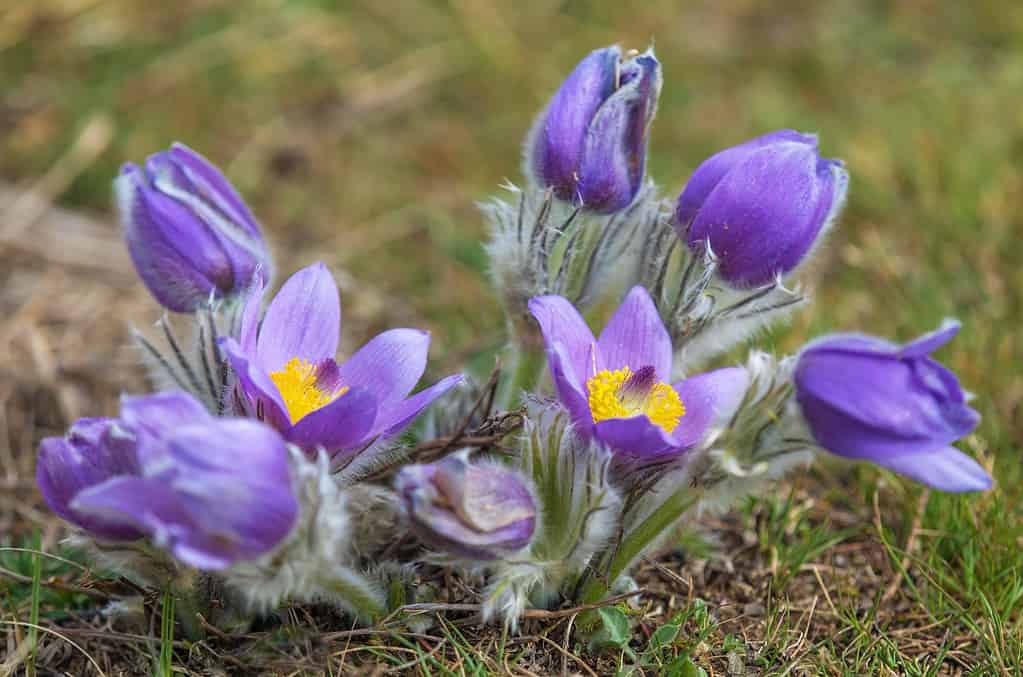
Pasqueflowers are usually purple and bloom around Easter.
©Daniel Prudek/Shutterstock.com
20. Petunia
This most popular plant delights with blooms that not only come in a great variety of vibrant colors but last from spring till the first killing frost. Native to South America, the petunia is often grown as a potted plant, though it can be planted in the garden as an annual. In really warm climates, such as zones 9 to 11, it is considered a perennial and planted outside in borders or as ground cover. The size of the flowers ranges from tiny milliflora, which are only about 1 inch across, to big grandifloras seen in hanging baskets. Full sun ensures that the petunia produces the most blossoms and also keeps the plant from getting leggy. The soil needs to be moderately fertile and drain well, especially if it’s potting soil.
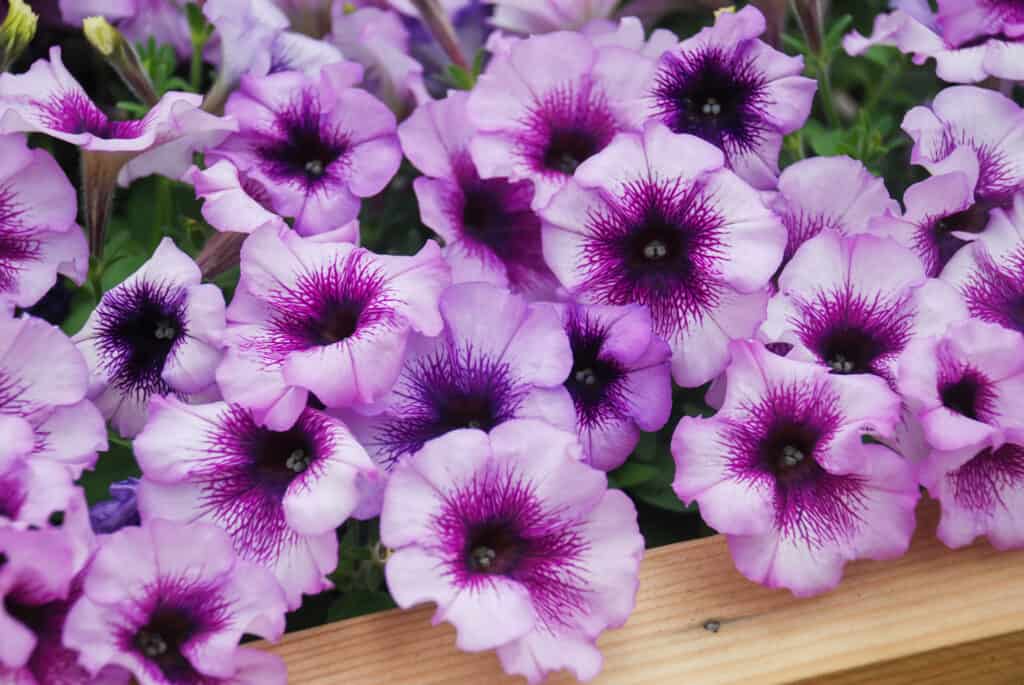
Full sun ensures that the petunia produces the most blossoms.
©Yui Yuize/Shutterstock.com
21. Pogonia
The pogonia, or snakemouth orchid, is a most beautiful orchid whose petals come in shades of delicate pink and rose. Its lip is bearded with white and yellow markings. This gives the plant its other name, beard flower. The plant produces only one flower per stem, and it gives off a mild fragrance, which is unusual for an orchid. In the wild, it grows in cool bogs from Canada to the Eastern United States. Because of this, it needs soil that is wet and acidic, but it is easy to care for. If it’s planted outside, it does best in hardiness zones 3 to 8 in full sun to part shade. The pogonia grows between 1 and 2 feet tall, and the beautiful flower appears in summer and lasts about two months.
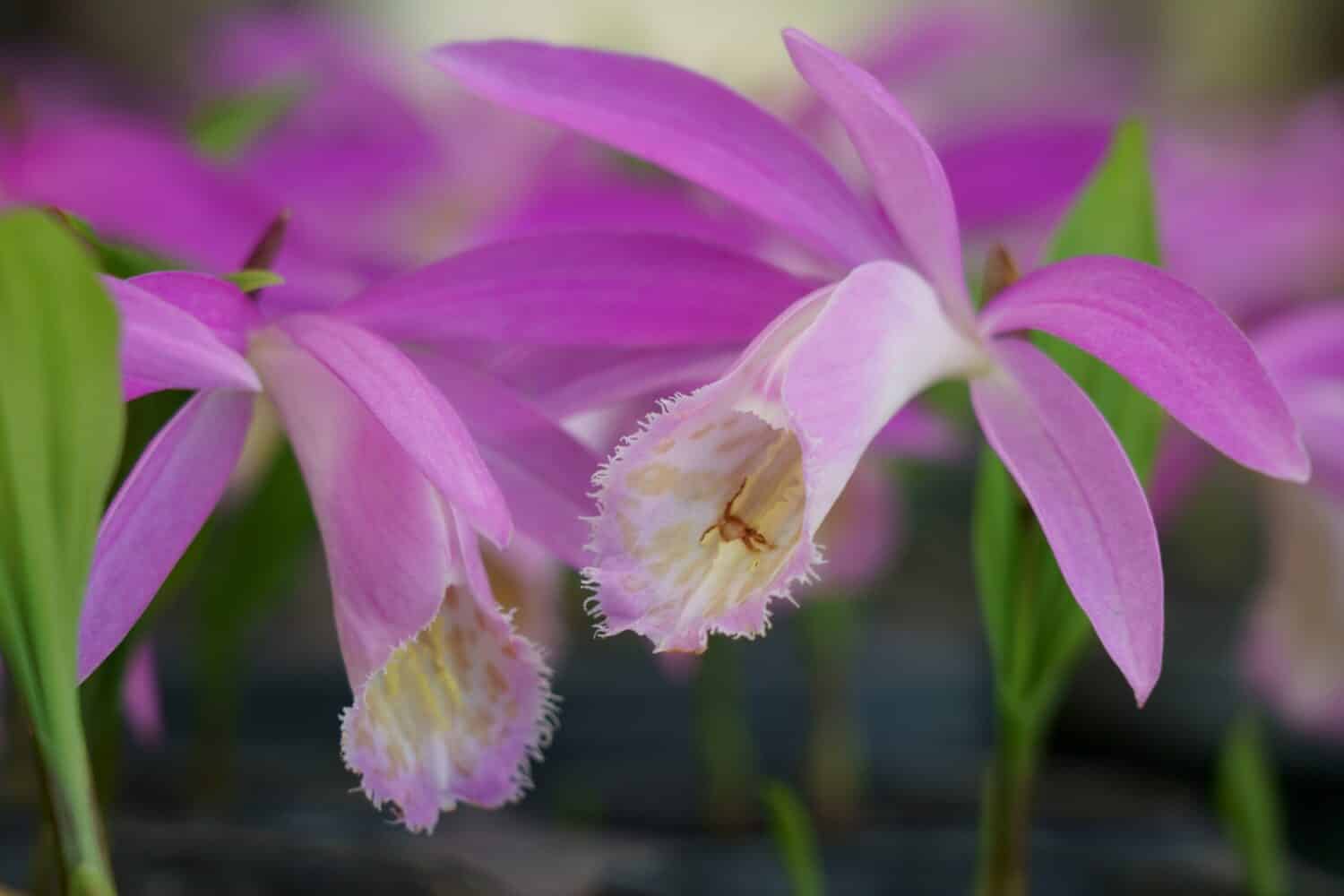
The pogonia, or snakemouth orchid, has beautiful petals that come in shades of delicate pink and rose.
©High Mountain/Shutterstock.com
22. Poinsettia
Nearly everyone knows this beautiful plant whose showy “flowers” arrive in time for Christmas. However, the white, pink, or sizzling red “flowers” of the poinsettia are not flowers at all, but bracts. The actual flowers are tiny and found in the centers of the bracts. One myth about this plant is that it’s deadly poisonous. While not deadly, it might make you a little sick if you eat it, and some people break out in a rash if they touch it. It’s definitely a good idea to keep it away from pets and other animals.
Named after Joel Poinsett, who was a botanist, as well as the United States’ first minister to Mexico, it grows as a shrub or even a small tree in its native habitat. It famously needs a bit of pampering to produce those bright bracts in time for Christmas. It needs about six to eight hours of darkness for a month and a half to two months for the bracts to turn red, then needs hours of brilliant sunlight for that red to be its brightest. Poinsettias can be kept as houseplants, though they probably won’t be as spectacular as they were that first Christmas. They can be planted outside in hardiness zones 9 to 11.
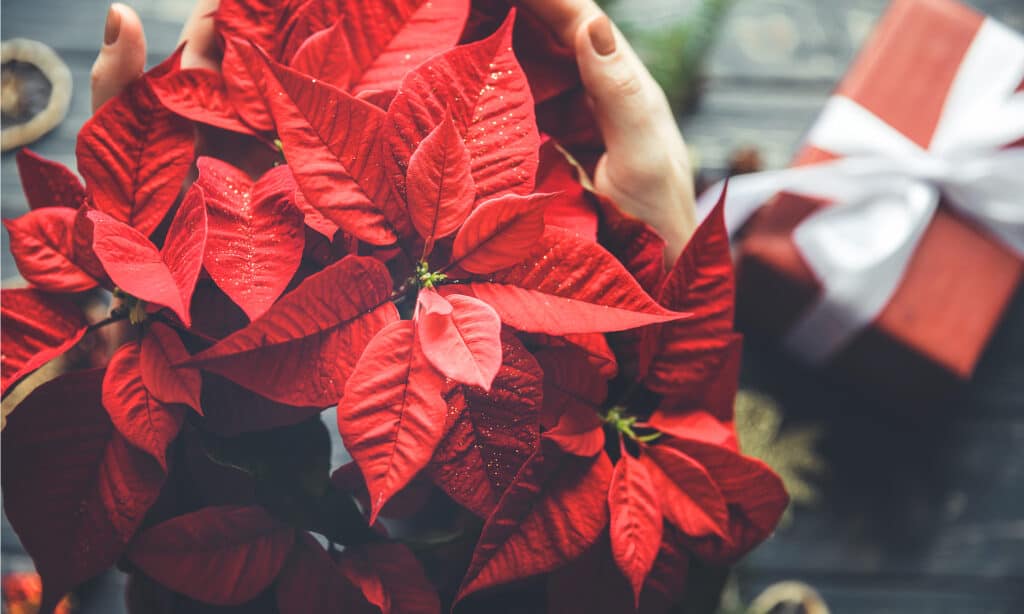
The cheerful red flowers of the poinsettia aren’t really flowers, but bracts.
©PinkCoffee Studio/Shutterstock.com
Full List of Flowers with P Names
- Peonies
- Pansies
- Penstemons
- Phlox
- Poppy
- Passionflower
- Pelargonium
- Periwinkle
- Pinks
- Pincushion Flower
- Primula
- Polemonium
- Portulaca
- Potentilla
- Prunella
- Pulmonaria
- Puschkinia
- Pyrethrum
- Pasqueflower
- Petunia
- Pogonia
- Poinsettia
The photo featured at the top of this post is © Anatolii Lyzun/Shutterstock.com
Thank you for reading! Have some feedback for us? Contact the AZ Animals editorial team.






